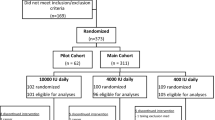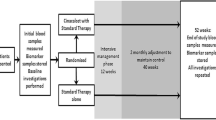Abstract
OBJECTIVE: To investigate via the vitamin D status whether patients with peripheral arterial disease (PAD) tend to develop vitamin D deficiency that in turn influences their clinical symptoms.
DESIGN: Cross-sectional.
SETTING: University hospital.
PATIENTS AND PARTICIPANTS: Three hundred twenty-seven patients were evaluated; subjects with secondary causes of bone disease or bone active medication were excluded. One hundred sixty-one patients with either PAD stage II (n = 84) or stage IV (n=77) were enrolled and compared to 45 age- and sex-matched healthy controls.
MEASUREMENTS AND MAIN RESULTS: All patients underwent determinations of serum chemistry, 25-hydroxyvitamin D (vitamin D3) intact parathyroid hormone (iPTH), alkaline phosphatase (ALP), and osteocalcin and were further stratified according to an individual restriction score into 3 groups: mildly, moderately, or severely restricted in daily life due to the underlying disease. Patients with PAD IV showed significantly lower vitamin D3 (P=.0001), and calcium (P=.0001) values and significantly higher iPTH (P=.0001), osteocalcin (P=.0001) and ALP (P=.02) levels as compared to patients with PAD II. Patients considering themselves as severely restricted due to the underlying disease showed lower vitamin D3 and higher iPTH levels than those who described only a moderate (vitamin D3: P<.001; iPTH: P<.01) or mild (vitamin D3: P<.001; iPTH: P<.001) restriction in daily life.
CONCLUSION: Patients with PAD IV, especially those who feel severely restricted due to the disease, are at high risk of developing vitamin D deficiency, secondary hyperparathyroidism, and ultimately osteomalacia due to immobilization and subsequent lack of exposure to sunlight, all of which in turn lead to further deterioration. Monitoring of vitamin D metabolism and vitamin D replacement therapy could be a simple, inexpensive approach to mitigating clinical symptoms and improving quality of life in patients with advanced PAD.
Similar content being viewed by others
References
Chalmers J, Conacher WD, Gardener DL, Scott PJ. Osteomalacia—a common disease in elderly women. J Bone Joint Surg Br. 1967;49:403–23.
Smith R, Stern G. Myopathy, osteomalacia and hyperparathyroidism. Brain. 1967;90:593–602.
Smith R, Stern G. Muscular weakness in osteomalacia and hyperparathyroidism. J Neurol Sci. 1969;8:511–20.
Mallette LE, Patten BM, Engel WK. Neuromuscular disease in secondary hyperparathyroidism. Ann Intern Med. 1975;82:474–83.
Skaria J, Katiyar BC, Srivastava TP, Dube B. Myopathy and neuropathy associated with osteomalacia. Acta Neurol Scand. 1975;51:37–58.
Schott GD, Wills MR. Muscle weakness in osteomalacia. Lancet. 1976;1:626–9.
Kruse HP. Osteomalazie. In: Allolio B, Schulte HM. Praktische Endokrinologie. München, Wien, Baltimore: Urban u. Schwarzenberg; 1996:302–9.
Malabanan A, Veronikis IE, Holick MF. Redefining vitamin D insufficiency. Lancet. 1998;351:805–06.
Parfitt AM. Osteomalacia and related disorders. In: Avioli LV, Krane SM, eds. Metabolic Bone Disease 3rd ed. San Diego, Calif: Academic Press; 1998:327–86.
Thomas MK, Lloyd-Jones DM, Thadhani RI, et al. Hypovitaminosis D in medical inpatients. N Engl J Med. 1998;338:777–83.
Dattani JT, Exton-Smith AN, Stephen JM. Vitamin D status of the elderly in relation to age and exposure to sunlight. Hum Nutr Clin Nutr. 1984;38:131–7.
McKenna MJ, Freaney R, Meade A, Muldowney FP. Hypovitaminosis D and elevated serum alkaline phosphatase in elderly Irish people. Am J Clin Nutr. 1985;41:101–9.
Reid IR, Gallagher DJ, Bosworth J. Prophylaxis against vitamin D deficiency in the elderly by regular sunlight exposure. Age Ageing. 1986;15:35–40.
Egsmose C, Lund B, McNair P, Storm T, Sorensen OH. Low serum levels of 25-hydroxyvitamin D and 1.25-dihydroxyvitamin D in institutionalised old people: influence of solar exposure and vitamin D supplementation. Age Ageing. 1987;16:35–40.
McKenna MJ. Differences in vitamin D status between countries in young adults and the elderly. Am J Med. 1992;93:69–77.
Holick MF. Environmental factors that influence the cutaneous production of vitamin D. Am J Med. 1995;61(3Suppl):638–45.
Holick MF. Vitamin D and bone health. J Nutr. 1996;126(4Suppl):1159–64.
Gloth FM III, Gundberg CM, Hollis BW, Haddad JG Jr., Tobin JD. Vitamin D deficiency in homebound elderly persons. JAMA. 1995;274:1683–6.
Gloth FM III, Tobin JD. Vitamin D deficiency in older people. J Am Geriatr Soc. 1995;43:822–8.
van der Wielen RP, Lowik MRH, van den Berg H, et al. Serum vitamin D concentrations among elderly people in Europe. Lancet. 1995;346:207–10.
Utiger RD. The need for more vitamin D. N Engl J Med. 1998;338:828–9.
Fraser DR. Vitamin D. Lancet. 1995;345:104–7.
Omdahl JL, Garry PJ, Hunsaker LA, Hunt WC, Goodwin JS. Nutritional status in a healthy elderly population: vitamin D. Am J Clin Nutr. 1982;36:1225–33.
Webb AR, Pilbeam C, Hanafin N, Holick MF. An evolution of the relative contributions of exposure to sunlight and of diet to the circulating concentrations of 25-hydroxyvitamin D in an elderly nursing home population in Boston. Am J Clin Nutr. 1990;51:1075–81.
Salamone LM, Dallal GE, Zantos D, Makrauer F, Dawson-Hughes B. Contributions of vitamin D intake and seasonal sunlight exposure to plasma 25-hydroxyvitamin D concentration in elderly women. Am J Clin Nutr. 1994;58:80–6.
Vieth R. Vitamin D supplementation, 25-hydroxyvitamin D concentrations and safety. Am J Clin Nutr. 1999;69:825–6.
Preece MA, Tomlinson S, Ribot CA. Studies of vitamin D deficiency in man. Q J Med. 1975;44:575–89.
Lips P, Hackeng WH, Jongen MJ, van Ginkel FC, Netelenbos JC. Seasonal variation in serum concentrations of parathyroid hormone in elderly people. J Clin Endocrinol Metab. 1983;57:204–6.
Lips P, Wiersinga A, van Ginkel FC. The effect of vitamin D supplementation on vitamin D status and parathyroid function in elderly subjects. J Clin Endocrinol Metab. 1988;67:644–50.
Dlugos DJ, Perrotta PL, Horn WG. Effects of the submarine environment on renal-stone risk factors and vitamin D metabolism. Undersea Hyperb Med. 1995;22:145–52.
Dawson-Hughes B, Harris SS, Dallal GE. Plasma calcidiol, season and serum parathyroid hormone concentrations in healthy elderly men and women. Am J Clin Nutr. 1997;65:67–71.
Feleke Y, Abdulkadir J, Mshana R, et al. Low levels of serum calcidiol in an African population compared to a North European population. Eur J Endocrinol. 1999;141:358–60.
Sherman SS, Hollis BW, Tobin JD. Vitamin D status and related parameters in a healthy population: the effects of age, sex and season. J Clin Endocrinol Metab. 1990;71:405–13.
Boonen S, Aerssens J, Dequeker J. Age-related endocrine deficiencies and fractures of the proximal femur: II implications of vitamin D deficiency in the elderly. J Endocrinol. 1996;149:13–7.
Stamp TCB, Round JM. Seasonal changes in human plasma levels of 25-hydroxyvitamin D. Nature. 1974;247:563–5.
Lester E, Skinner RK, Wills MR. Seasonal variation in serum-25-hydroxyvitamin D in elderly in Britain. Lancet. 1977;1:979–80.
Juttmann JR, Visser TJ, Buurman C, de Kam E, Birkenhäger JC. Seasonal fluctuations in serum concentrations of vitamin D metabolites in normal subjects. BMJ. 1981;282:1349–52.
Chapuy MC, Preziosi P, Maamer M, et al. Prevalence of vitamin D insufficiency in an adult normal population. Osteoporos Int. 1997;7:439–43.
Chel VJ, Ooms ME, Popp-Snijders C, et al. Ultraviolet irradiation corrects vitamin D deficiency and suppresses secondary hyperparthyroidism in the elderly. J Bone Miner Res. 1998;13:1238–42.
Harris SS, Soteriades E, Coolidge JA, Mudgal S, Dawson-Hughes B. Vitamin D insufficiency and hyperparathyroidism in a low income, multiracial, elderly population. J Clin Endocrinol Metab. 2000;85:4125–30.
Chapuy MC, Schott AM, Garnero P, Hans D, Delmas PD, Meunier PJ, and the EPIDOS STUDY GROUP. Health elderly French women living at home have secondary hyperparathyroidism and high bone turnover in winter. J Clin Endocrinol Metab. 1996;81:1129–33.
Bischoff H, Stahelin HB, Vogt P, et al. Immobility as a major cause of bone remodeling in residents of a long-stay geriatric ward. Calcif Tissue Int. 1999;64:485–9.
Pfeifer M, Begerow B, Minne HW, et al. Vitamin D status, trunk muscle strength, body sway, falls and fractures among 237 postmenopausal women with osteoporosis. Exp Clin Endocrinol Diabetes. 2001;109:87–92.
Lips P, Duong T, Oleksik A. A global study of vitamin D status and parathyroid function in postmenopausal women with osteoporosis: baseline data from the multiple outcomes of raloxifene evaluation clinical trial. J Clin Endocrinol Metab. 2001;86:1212–21.
Glerup H, Mikkelsen K, Poulsen L, et al. Hypovitaminosis D myopathy without biochemical signs of osteomalacic bone involvement. Calcif Tissue Int. 2000;66:419–24.
Demiaux B, Arlot ME, Chapuy MC, Meunier PJ, Delmas PD. Serum osteocalcin is increased in patients with osteomalacia: correlations with biochemical and histomorphometric findings. J Clin Endocrinol Metab. 1992;74:1146–51.
Ooms ME, Roos JC, Bezemer PD, van der Vijgh WJ, Bouter LM, Lips P. Prevention of bone loss by vitamin D supplementation in elderly women: a randomized double-blind trial. J Clin Endocrinol Metab. 1995;80:1052–8.
Pfeifer M, Begerow B, Minne HW, Abrams C, Nachtigall D, Hansen C. Effects of a short-term vitamin D and calcium supplementation on body sway and secondary hyperparathyroidism in elderly women. J Bone Miner Res. 2000;15:1113–8.
Chapuy MC, Arlot ME, Duboeuf F. Vitamin D3 and calcium to prevent hip fractures in elderly women. N Engl J Med. 1992;327:1637–42.
Chapuy MC, Arlot ME, Delmas PD, Meunier PJ. Effect of calcium and cholecalciferol treatment for three years on hip fractures in elderly women. BMJ. 1994;308:1081–2.
Meunier PJ, Chapuy MC, Arlot ME, Delmas PD, Duboeuf F. Can we stop bone loss and prevent hip fractures in the elderly? Osteoporos Int. 1994;4(Suppl 1):71–6.
Lips P, Graafmans WC, Ooms ME, Bezemer PD, Bouter LM. Vitamin D supplementation and fracture incidence in elderly persons: a randomised, placebo-controlled trial. 1996;124:400–6.
Dawson-Hughes B, Harris SS, Krall EA, Dallal GE. Effect of calcium and vitamin D supplementation on bone density in men and women 65 years of age or older. N Engl J Med. 1997;337:670–6.
McDermott MM, Kerwin DR, Liu K, et al. Prevalence and significance of unrecognised lower extremity peripheral arterial disease in general medicine practice. J Gen Intern Med. 2001;16:384–90.
Author information
Authors and Affiliations
Corresponding author
Rights and permissions
About this article
Cite this article
Fahrleitner, A., Dobnig, H., Obernosterer, A. et al. Vitamin D deficiency and secondary hyperparathyroidism are common complications in patients with peripheral arterial disease. J GEN INTERN MED 17, 663–669 (2002). https://doi.org/10.1046/j.1525-1497.2002.11033.x
Issue Date:
DOI: https://doi.org/10.1046/j.1525-1497.2002.11033.x




